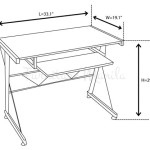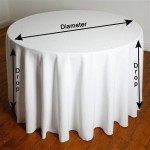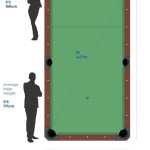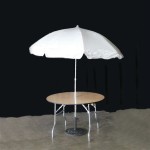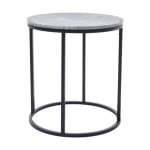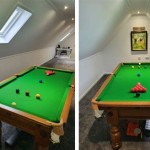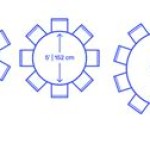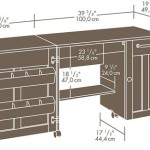Round Table Size for 6 People: A Comprehensive Guide
Selecting the appropriate round table size for seating six individuals requires careful consideration. Factors such as comfort, available space, and the intended use of the table all contribute to determining the optimal diameter. A table that is too small will feel cramped, hindering conversation and making dining uncomfortable. Conversely, a table that is too large may feel isolating and consume excessive floor space. This article provides a detailed exploration of the considerations necessary to select the ideal round table size for six people, ensuring both functionality and aesthetic appeal.
The primary objective in determining the appropriate size is to provide each seated person with adequate personal space. This includes sufficient room to comfortably eat, converse, and move without feeling confined or encroaching on the personal space of others. Minimum space requirements must be met to ensure a pleasant dining or working experience. Understanding these spatial needs forms the basis for choosing the correct table dimensions.
Furthermore, the intended purpose of the round table plays a significant role. A dining table used for formal meals will have different spatial requirements than a table used for casual board games or collaborative work sessions. Each activity impacts the need for surface area, and the overall experience is enhanced by a table that comfortably accommodates its specific function.
Determining Minimum Diameter for Comfortable Seating
The commonly accepted minimum diameter for a round table seating six people is 48 inches (122 centimeters). This measurement provides a foundational understanding of the spatial requirements. At 48 inches, each person has approximately 24 inches of perimeter space. While this size technically accommodates six individuals, it can often feel cramped, particularly if place settings are elaborate or if substantial serving dishes are placed on the table. This size is best suited for situations where space is severely limited or for informal gatherings with minimal table settings.
For a more comfortable dining experience, a diameter of 54 inches (137 centimeters) is generally recommended. This provides each person with approximately 28 inches of perimeter space, affording more room for movement and allowing for larger plates and serving dishes. The additional six inches of diameter significantly improves the overall dining experience, reducing the feeling of being crowded around the table. This size represents a good balance between functionality and space efficiency, suitable for both everyday meals and small gatherings.
When considering formal dining or occasions where ample space is desired, a diameter of 60 inches (152 centimeters) or larger should be considered. At 60 inches, each person has approximately 31 inches of perimeter space, offering a luxurious amount of room for comfortable dining and unrestricted conversation. This size is particularly well-suited for larger homes or dining rooms where space is not a primary constraint. It allows for elaborate table settings, large serving dishes, and a more relaxed and spacious dining environment.
It's important to note that these are general guidelines. The ideal diameter will vary based on the specific chairs used. Chairs with arms will require more space than armless chairs. The physical dimensions of the individuals who will be using the table should also be taken into account. In cases where users tend to be larger in stature, a slightly larger table may be preferable to ensure everyone is comfortable.
Accounting for Table Base and Leg Design
The design of the table base or legs significantly impacts the usable space beneath the table. A pedestal base, for example, offers the most legroom and allows for unrestricted movement. This is especially important for larger individuals or those who prefer more leg space. Pedestal bases also minimize the risk of bumping knees against table legs, enhancing comfort during extended periods of sitting.
Tables with four legs, particularly those with legs positioned close to the corners, can restrict legroom and potentially create awkward seating positions. When considering a table with four legs, it is crucial to ensure that the leg placement allows for comfortable seating for all six individuals. The legs should be positioned in a way that maximizes the available space under the table and minimizes the risk of interference with chairs or legs.
Some tables feature trestle bases, which consist of a central support system with a horizontal beam connecting two vertical supports. While trestle bases can be aesthetically pleasing, they can also limit legroom, particularly for individuals seated near the supports. Careful consideration should be given to the design of the trestle base to ensure that it does not impede comfortable seating. The width and placement of the trestle supports should be evaluated in relation to the number of seats and the overall table diameter.
When possible, it's advisable to physically test the table base with chairs and seated individuals to assess the actual legroom available. This allows for a practical evaluation of the design and ensures that it meets the needs of all users. Online reviews and manufacturer specifications can provide insights into the table base design and its potential impact on legroom, but a physical assessment is always the most reliable method.
Considering Room Size and Table Placement
The size of the room and the placement of the round table are crucial elements in ensuring a harmonious and functional space. Adequate clearance around the table is necessary to allow for comfortable movement and easy access to seating. A general guideline is to allow at least 36 inches (91 centimeters) of space between the edge of the table and any walls or furniture. This space provides sufficient room for individuals to pull out chairs, walk around the table, and serve food without feeling constricted.
In smaller rooms, it may be necessary to compromise on table size to maintain adequate clearance. In such cases, a 48-inch or 54-inch round table may be more appropriate than a larger 60-inch table. The priority should be to balance the seating capacity with the overall usability of the room. Cramped spaces can hinder movement, making the room feel smaller and less inviting.
The shape of the room also influences table placement. Square or rectangular rooms offer greater flexibility in terms of table positioning compared to rooms with irregular shapes. In rooms with alcoves or angled walls, careful planning is required to ensure that the table is placed in a way that maximizes space and minimizes obstructions.
When positioning the table, consider the relationship to other furniture in the room. Avoid placing the table in a location where it obstructs doorways or walkways. Ensure that there is ample space for chairs to be pulled out without bumping into other furniture. The goal is to create a functional and aesthetically pleasing arrangement that enhances the overall flow of the room.
The availability of natural light also plays a role in table placement. Ideally, the table should be positioned in a location where it receives ample natural light, creating a bright and inviting atmosphere. Avoid placing the table in a dark or poorly lit corner, as this can make the space feel less welcoming. The strategic use of artificial lighting can also supplement natural light and enhance the overall ambiance of the room.
Ultimately, the determination of the optimal round table size and placement for six people requires a holistic approach, considering factors such as comfort, legroom, room size, and overall functionality. By carefully evaluating these elements, it is possible to select a table that meets the specific needs of the users and enhances the overall dining or working experience.

Result For Round Dining Table 6 Dimensions Sizes 8 Person

Dining Table Dimensions Measurements

Table Measures Dining Dimensions Sizes 8 Person Round

81 Reference Of 6 Chair Round Table Size Dining Guide Sizes
How Much Space Is Required For A 6 Seater Dining Table Quora

How Do I Choose The Right Size Of Solid Wood Dining Table Set For My S Picket Rail Custom Furniture Interiors

Pin By Oana Tiution On Dinning Room Dining Table Sizes 12 Person 6 Seater

Gojane 47 2 In Round Gray Mid Century Modern Dining Table For 4 6 Person With Steel Legs Seats Wf194539lwyaae The Home Depot

How To Calculate The Best Dining Table Size For Your Room

Dining Table Design Basics Tablelegs Com
Related Posts

